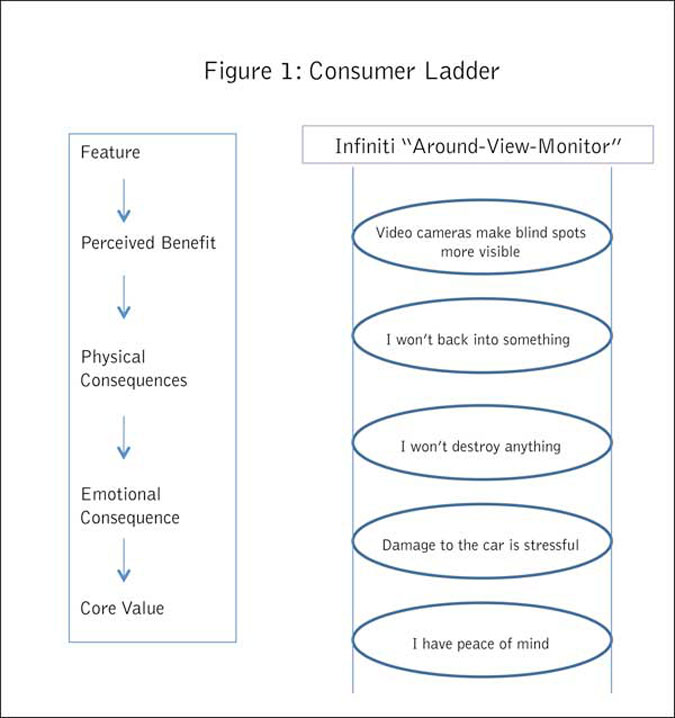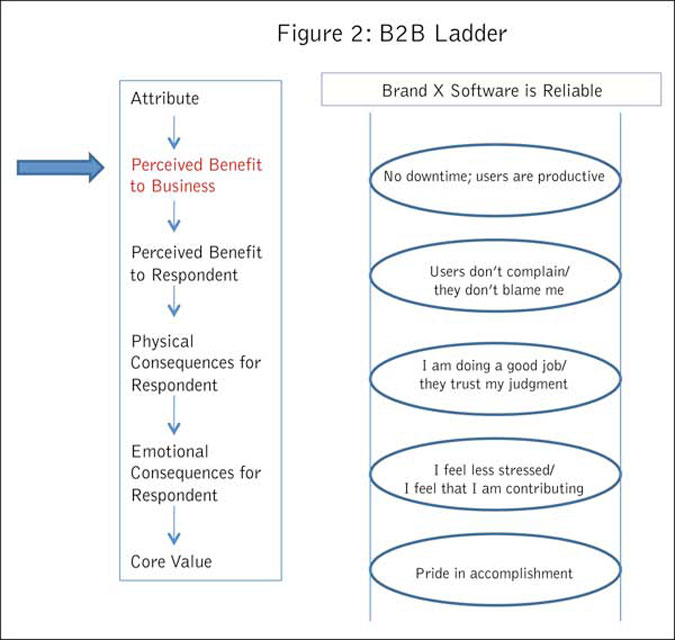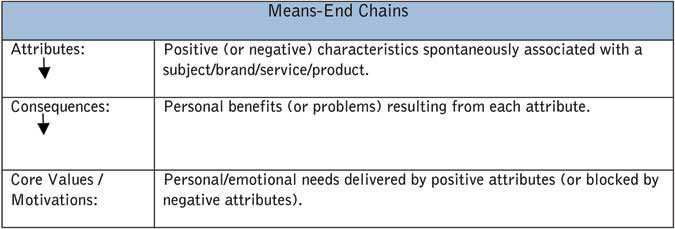Get to the point
Editor’s note: Bernadette DeLamar is managing partner of Nuance Research LLC, Reston, Va.
Once, many years ago, I fell in love with an automobile - a brand ideal, I suppose, communicated by words and images that resonated strongly with my particular needs and values: my nerdiness, practicality and aspirations to “coolness.” The October, 2009 article in Quirk’s by Matt Schroder (“Getting to the bottom of things”) on Infiniti’s use of laddering brought this all vividly back to me - the joy of finding and buying (secondhand of course) that small, boxy, but totally cool German car that struck such a strong chord in my psyche during those first years out of grad school.
Shortly after reading the laddering article, I noted several posts from members of various research-related groups on LinkedIn inquiring about the use of laddering techniques in B2B studies. How, some asked, does one go about (or should one even try going about) using laddering techniques among business and professional respondents - among those whose emotive linkage to a brand or feature is mitigated by an intervening variable, that is, the company or organization for which decisions are made?
Purchasing professionals do not appear to “fall in love” with copy machines or printers or office supplies. IT professionals do not seem to be enthralled with their servers or desktops or enterprise software. And, as our professors drilled into us in business school, business decisions are and should be entirely rational. One can and should build a model, construct a cost-benefit analysis, assess ROI and possibly even work through a lease/buy decision tree. In addition, successful communications designed for the business audience must be feature/function-specific.
Yet, over the years, I have interviewed countless IT decision makers and PC end users who profess to “love” their software applications - IBM’s Lotus Notes comes to mind for the creativity and collaboration the software enables, or, as another example, database administrators say they are “devoted to” their Oracle software for its power and flexibility. I’ve talked to software architects who profess to be “really excited” about a particular technology, as well as small-business people who are “totally thrilled” with the potential of new, speedier customer payment services.
If purchase decision-making among brands, features, services, etc., in B2B markets is supposedly perfectly rational, how does one explain the presence and driving influence of such strong feelings, brand loyalties, etc.? Obviously, products, services and brands have consequences for both the company/organization for which they are purchased as well as for the individual or team doing the purchasing. The challenge to discovering these influences, then, is to connect the consequences to basic human motivations, emotions and values in such as way as to clearly delineate:
-
What does it matter to the organization? (Why is that important for your business?)
-
How does that affect the respondent? (Why is that important to you?)
We need to understand how the rational attributes/features of our offerings link through intervening organizational benefits to the purchaser’s core emotional benefits and values.
Adapt the process
As Schroder explained in his article, laddering “…uses a series of probes (such as ‘why is that important to you?’) to generate means-end chains, or ladders, related to a product or service feature or attribute.” The chart showing means-end chains illustrates the standard laddering process or framework.
To meet the challenges posed by laddering in B2B studies, we need to adapt the process to meet the more complex situations posed by business respondents. Experience has led me to the following adaptations:
-
I clue in respondents as to what we are doing as well as the actual goal of the interview process itself.
-
I add an additional layer to the chain (a “rung” to the ladder) wherein attributes are linked to the organization/business itself.
-
I adhere to a more rigorous structure than we might with consumers, to forestall impatience and annoyance among these busy respondents.
Cluing in respondents
Business respondents typically come to a research interview or focus group wearing their rational business hats. They are quite used to evaluating products and services and even brands based on various rational criteria, e.g., return on investment, price/performance, product support offered, etc. They come to market research expecting questioning regarding their purchase criteria or process, or their evaluation of features, value, price, or their reaction to advertising, and so on. As with a consumer respondent, then, the moderator will want to clue in a business respondent that the interview will be a bit different from what might be expected. Beyond setting the stage and illustrating the laddering process, as we might do for a consumer, we have found that we need to provide an explicit explanation of our objective. For example: “To understand how Brand/Service/Product X affects you, personally, in your business and real life, and in what you have to accomplish every day.”
A segue such as this typically works very well in easing a business respondent into the rather unusual laddering process that follows.
Adding a rung to theladder
Climbing the rungs of the ladder, as illustrated in the Infiniti example cited in Schroder’s article, is process of moving from attribute or feature through physical to emotional consequences to an emotional end state or core value for the respondent. If we were to illustrate the example from the article, it might look like the one shown in Figure 1.
In the case of B2B products and services, we need to add a rung to the ladder for the intervening variable that affects the respondent (or for which the respondent is making the purchase decision). We need to add a rung for the business or organization itself. The revised structure might now look like the one shown in Figure 2.
The question series now follows a more complex structure:
-
What is the benefit of Attribute X for the business/organization?
-
How does that benefit impact the respondent? (That is, what is its benefit for the respondent him/herself, or why is that important to the respondent?)
Adhering to the structure
Even among consumers, a relentless series of “Why is that important?” probes can lead to frustration and a desire to say anything just to get the drilling to stop. I surmise that the probes that great moderators actually use are something on the order of their “trade secrets.” After all, it is common advice to avoid “why” questions in research, given that the response is often “Why not?”
The trade secret for business respondents, then, is a rigorous application of the questioning structure, together with a series of very targeted probes. A questioning series might proceed along this structure:
Regarding (Attribute/Feature) X:
-
What is the benefit of that attribute/feature to your business?
-
And how does that benefit you, personally?
-
And when you have that benefit in your life, what is the consequence of that for you (or, what is the upside of that for you; or, for what reason is that meaningful/important to you)?
-
And when that happens/exists, how does that make you feel?

The goal is to elicit responses until the respondent reaches an emotional end state such as security or happiness or accomplishment or peace of mind. As Schroder mentions, it is often useful to use the Maslow hierarchy of needs as a heuristic device for identifying such end states. And, because we are attempting to get the respondent to that last rung of the ladder, a response to “How does that make you feel?” on the order of “It makes me feel good” is not an acceptable endpoint. In this context, “good” needs refinement and definition through additional coaxing.
Applying the structure rigorously has proven highly successful among busy business professionals. Simply employing a series of seemingly directionless probes (e.g., Why is that important to you?) can leave respondents exasperated and uncooperative. Give them a structure, however, and they “get it.” A few (perhaps two in 10) will complete laddering chains practically on their own without any probes. On the other hand, a different few (perhaps one in 10) will not get it at all, and never be able to reach even an emotional consequence, much less a core value or motivation, which is, of course, why we conduct multiple interviews.
Break through the clutter
Given that so much of business marketing communications is feature/function-focused, and given that many business products/services are commodities, B2B marketers need a means to break through the clutter. The results of a laddering study can provide the content and imagery that will enable a brand/product/service to rise above the noise by connecting the rational features/attributes valued by the purchaser with his or her personal goals and motivations.
